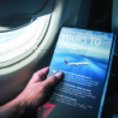Connecting Flight
March 31, 2018


Agrowing number of fliers view staying connected in flight as a must-have according to a new survey published by Inmarsat. The annual Inflight Connectivity Survey finds that the majority of global passengers now see inflight connectivity as a necessity, not a luxury. The poll of over 8,000 passengers worldwide reveals that 60 percent see inflight connectivity as essential, and 66 percent of parents traveling with children characterize inflight connectivity as a “life saver.”
As a consequence, air carriers are quickly beefing up their inflight WiFi offerings. According to Routehappy’s 2017 WiFi report, nearly 40 percent of all flights worldwide either already offer WiFi service or soon will. US airlines lead the development, with 83 percent of flights now offering WiFi access, the report said.
“The industry has made great strides since last year’s report, with more aircraft connected than ever before, including 11 airlines that now offer inflight WiFi for the first time,” according to the report, which said aircraft WiFi access is up 8 percent globally since 2016.
The report found a “dramatic shift away” from basic WiFi access to faster systems on aircraft, a response to customer needs. Currently, 7.2 percent of flights offer top-tier WiFi access (with speeds capable of streaming video), up 1.2 percent from 2016. An additional 61 percent offer “better” WiFi (full web browsing with limited streaming capability), while a minority of flights (31.9 percent) still have basic, low-speed WiFi.
The proportion of flights with basic WiFi fell 9.1 percent between 2016 and 2017, while those providing better WiFi rose 7.9 percent.
It Takes Teamwork
Those results underscore the burgeoning demand the aviation industry is facing for a better inflight WiFi experience. Among the initiatives being launched to address the need, the five founding members of the Seamless Air Alliance – Airbus, Delta, OneWeb, Sprint, and Bharti Airtel (“Airtel”) – have announced the alliance is now open to new industry players with the mission of creating a seamless WiFi connectivity experience for passengers on the ground and in the air.
The purpose, according to the organization’s website, is to “accelerate the introduction of technologies on board airplanes to enable passengers to use their connected devices (Smart phones, tablets, laptops, watches, IoT devices) in a seamless way.” The goal is to allow the passenger’s devices to connect easily “without any login or credit cards needed, enabled through your current mobile operators platform.”
As Gil West, Delta’s senior EVP and chief operating officer puts it: “We know that Delta customers have an expectation that their Internet connection just works – no matter where they are in their travel journey. We are excited to be collaborating with other visionary companies, and that our existing partner Gogo will be joining the alliance.”
Indeed inflight WiFi pioneer Gogo was one of the first to join the Seamless Alliance. “We look forward to working with the Alliance to develop future generations of inflight connectivity, which will provide airline passengers worldwide with simple, fast and reliable connectivity,” says Michael Small, CEO of Gogo.
Meanwhile, across the Atlantic the European Aviation Network is working toward a launch of the world’s first hybrid satellite and air-to-ground network. EAN combines high-speed broadband satellite coverage with a complementary 4G LTE ground network. The system is planned to provide connectivity across all 28 European Union states, specifically in high-traffic flight paths and busy airport hubs.
A collaboration between Inmarsat and Deutsche Telekom, EAN has already launched its S-band satellite and cleared initial airworthiness tests. On the airline side, launch partner IAG Group and its airlines British Airways, Iberia, Aer Lingus and Vueling are in the process of outfitting their aircraft with the new technology with the goal of having 90 percent of its short haul fleet complete by early 2019.
The EAN system promises to deliver speeds of over 50GB per second, offering reliable broadband service in the air that matches what passengers have come to expect on the ground. After years of frustrating delay, the project is tentatively set for a June rollout, although no date has actually been announced for the first fully operational flights.
The Long & Winding Road
The search for inflight connectivity reliability and speed has been a long and arduous one. As ground-based systems have become faster and cheaper, the expectation on the part of consumers is that WiFi connectivity will simply be everywhere. But the challenges of technology, standardization and cost at 35,000 feet have proven to be more daunting.
However the initiatives appear to be bearing fruit. Otto Gergye, Asia-Pacific VP at Inmarsat likens the adoption of inflight WiFi to fully flat beds, noting that development really wasn’t considered essential by consumers until almost every airline had them. “When it was only one flight, it wasn’t really a purchase decision. But when it was on all flights, people would choose to fly on that airline because they’re guaranteed a flat bed. It’s kind of the same with WiFi.”
Indeed, the tide appears to be moving in that direction. A new study by the London School of Economics in collaboration with Inmarsat estimates that inflight connectivity will be a market worth $130 billion by 2035. In real terms, the analysis found on average passengers will become $4 more valuable to airlines through ancillary revenues (an increase over current ancillary revenues which are worth $17 per passenger).
Based on current IATA data and industry sources, the study predicts broadband enabled ancillary revenues for airlines will come from four main revenue streams:
• Broadband access charges – providing connectivity to passengers inflight
• e-commerce and destination shopping – making retail purchases on-board aircraft with expanded product ranges and real-time offers.
• Advertising – pay-per-click, impressions, sponsorship deals with advertisers
• Premium content – providing live content, on demand video and bundled W-IFEC access
Low-cost carriers, in particular, are where Gergye sees much of the potential growth in the inflight WiFi space coming from. “I think it’s the ultimate ancillary and the LCCs are going to love inflight WiFi,” he says. “Sure it takes four days to install, but once it’s there it’s there, and you can just sell it again and again. The good ancillaries are the ones where you have few or no logistics.”
As for other ways onboard WiFi will begin to change flight experience, Gergye sees obtaining real-time customer insights as being a key area. Inflight, he says, “is the time to undertake passenger surveys. It’s very different when you’re asked during your flight than two days later. ‘How is the service? Are you having a fantastic time or are you feeling that you’re being treated as second-best?’ We shouldn’t underestimate that sort of cost and the value that brings.”
Shopping is similarly something Gergye sees as being markedly improved by WiFi, noting that people have the capability and plenty of time to purchase. “I think there will be an uptake in anything that you can sell to people, because people have time, and they’re bored.”
According to the RouteHappy survey, JetBlue is leading the way among US carriers offering the best WiFi, while some United aircraft also are equipped with high-speed Internet access. Worldwide, Delta, United, American, Emirates, and Southwest had the greatest percentage of their flights equipped with WiFi (as calculated by airline seat miles, or ASMs).
However, airlines in Asia-Pacific appear to be making strategic moves to better integrate it into their aircraft and improve their offerings.
• Singapore Airlines has begun offering complimentary inflight WiFi to premium travelers as well as PPS Club members when flying on-board select aircraft.
• All Nippon Airways (ANA) will introduce free WiFi on its domestic fleet beginning April 1. The service will be made available on 100 planes to passengers of all classes by the end of 2018 and will be marked by the ANA WiFi service logo near the entrance.
• Cathay Pacific Group’s entire wide-body fleet will be outfitted with inflight WiFi. The rollout is expected to begin in mid-year, with completion currently slated for 2020.
• Australian carriers Qantas and Virgin Australia have both been running domestic trials. Air New Zealand, which will utilize Inmarsat’s new global GX satellite constellation, is in the process of adding it to its aircraft.
• And Japan Airlines recently began offering free WiFi on all domestic flights.




